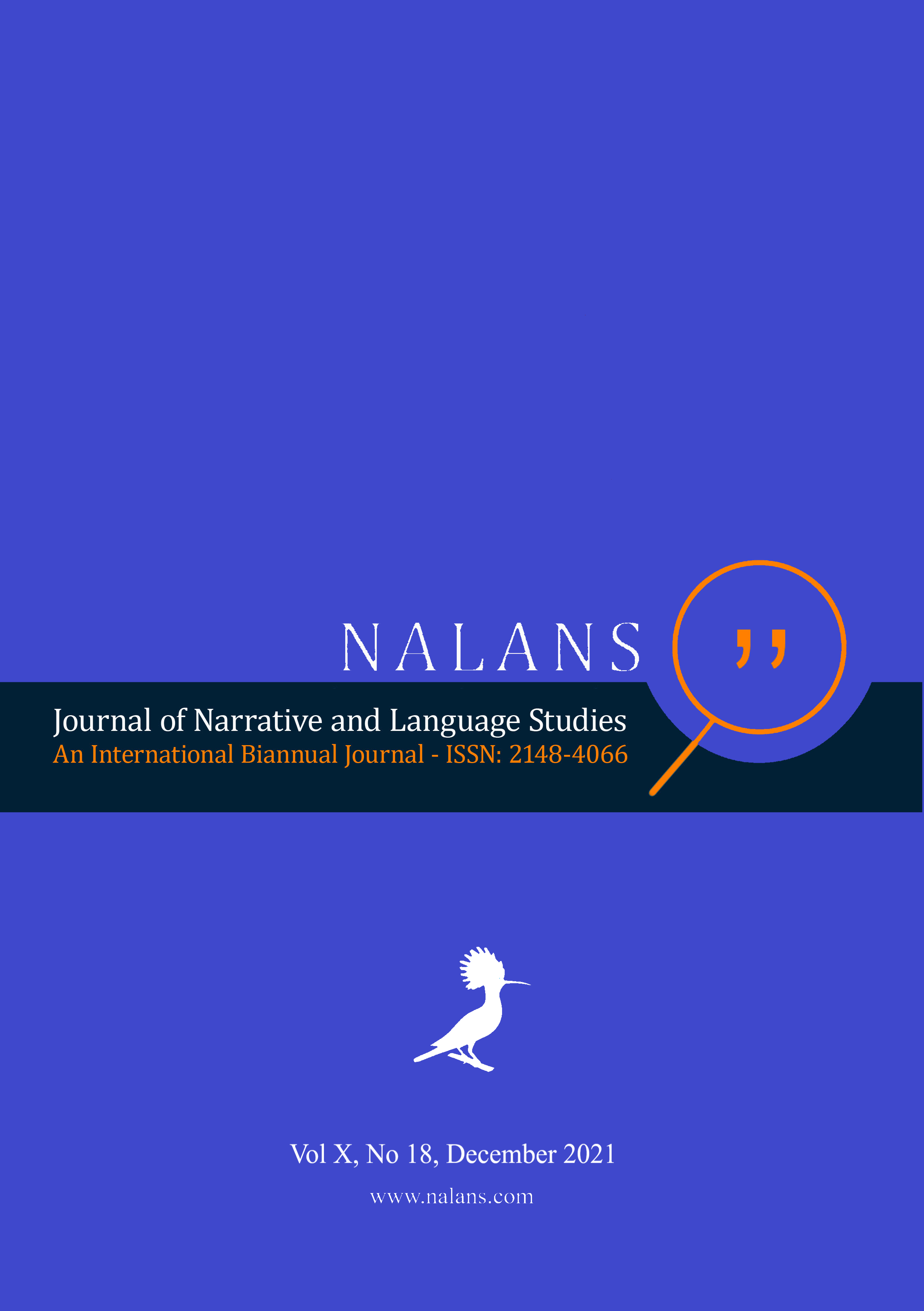An Ecocritical Reading of Cynan Jones’s The Long Dry
Keywords:
Ecocriticism, deep ecology, ecofeminism, The Long Dry, Cynan JonesAbstract
Ecocriticism emerged in the 1900s as an interdisciplinary academic discipline that combines ecology and literature by addressing the causes and consequences of environmental problems. Ecocriticism, which uses literature to shape ecological consciousness, offers a biocentric perspective by considering the concept of humans in a variety of ways. As a result, the formative role that ecocriticism establishes between nature and humans becomes more important. Deep ecology contributes to the development of ecocriticism by examining the relationship between human and non-human nature. Ecofeminism, on the other hand, adds a new perspective to ecocriticism by making investigations related to the relationship between women and nature. In his works dominated by Welsh nature, contemporary Welsh author Cynan Jones deals with the relationships between nature and humans, and nature is presented as a character rather than a background. In doing so, he allows the reader to see the relationship with nature in a broader light. The aim of this study is to examine nature and human relationships in Jones's, a rural-based author, short novel The Long Dry from an ecocritical perspective, as well as to practically address the place of ecocriticism in fiction.
References
Ayaz, H. (2014). “Çevreci Eleştiri Üzerine Genel Bir Değerlendirme”.[ A General Evaluation of Environmental Criticism]. Uluslararası Türkçe Edebiyat Kültür Eğitim Dergisi, 3(1), 278-292.
Buell, L. (2005). The Future of Environmental Criticism: Environmental Crisis and Literary Imagination. U.K: Blackwell Publishing.
Des Jardins, J. R. (2012). Environmental Ethics an Introduction to Environmental Philosophy. USA: Wadsworth Cengage Learning.
Devall, B. (1980). “The Deep Ecology Movement” Natural Resources Journal, 20 (2), 299-322.
Devall, B. (1982). “John Muir as Deep Ecologist”. Environmental Review: ER, 6(1), 63-86.
Devall, B. & Sessions, G. (1985). Deep Ecology: Living as if Nature Mattered. Salt Lake City: Peregrine Smith Books.
Dryzek, J. (2013). The Politics of the Earth: Environmental Discourses. New York: Oxford University Press.
Estok, S. C. (2001). “A Report Card on Ecocriticism”. AUMLA: The Journal of the Australasian Universities Language and Literature Association, 96 (1), 220-238.
Ferry, L. (1995). The New Ecological Order. Chicago & London: University of Chicago Press.
Garrard, G. (2004). Ecocriticism. London and New York: Routledge.
Glotfelty, C. (1996). “Introduction Literary Studies in an Age of Environmental Crisis” In C. Glotfelty & H. Fromm (Eds.), The Ecocriticism Reader: Landmarks in Literary Ecology (pp. xv-xxxvii). Athens and London: University of Georgia Press.
Haraway, D. J. (2016). Manifestly Haraway. London: University of Minnesota Press.
Hinchman, L. P. & Hinchman, S. K. (1989). “"Deep Ecology" and the Revival of Natural Right”. The Western Political Quarterly, 42(3), 201-228.
Jones, C. (2014). The Long Dry [Kindle version]. Retrieved from amazon.com.
Katz, E. (1991). “Ethics and Philosophy of the Environment: A Brief Review of the Major Literature”. Environmental History Review, 15(2), 79-86.
Love, G. A. (1996). “Revaluing Nature, Toward an Ecological Criticism”. In H. Fromm & C. Glotfelty (Eds.), The Ecocriticism Reader: Landmarks in Literary Ecology (pp. 225-240). Athens and London: University of Georgia Press.
Marland, P. (2013). “Ecocriticism”. Literature Compass, 10(11), 846-868.
Mathews, F. (1988). “Conservation and Self-Realization: A Deep Ecology Perspective”. Environmental Ethics, 10(4), 347-355.
Mazel, D. (2001). “Introduction”. In D. Mazel (Ed.), A Century of Early Ecocriticism (pp. 1-19). Athens and London: The University of Georgia Press.
Merchant, C. (1989). The Death of Nature: Women, Ecology, and the Scientific Revolution. New York: HarperCollins Publishers.
Merchant, C. (1990). “Ecofeminism and Feminist Theory” In I. Diamond & G. F. Orenstein (Eds.), Reweaving the World: The Emergence of Ecofeminism (pp. 100-105). San Francisco: Sierra Club Books.
Mies, M. & Shiva, V. (1993). Ecofeminism. Hallifax, Nova Scotia: Fernwood Publishing.
Murphy, P. D. (2009). Eco critical Explorations in Literary and Cultural Studies, Fences, Boundaries, and Fields. U.S.A.: Lexington Books.
Naess, A. (1973). “The Shallow and the Deep, Long-Range Ecology Movement. A Summary”. Inquiry An Interdisciplinary Journal of Philosophy, 16(1-4), 95-100.
Naess, A. (1989). Ecology, community and lifestyle: Outline of an Ecosophy. Cambridge: Cambridge University Press.
Naess, A. (2005). “The Deep Ecology Movement: Some Philosophical Aspects”. OpenAirPhilosophy.https://openairphilosophy.org/wpcontent/uploads/2019/02/OAP_Naess_Deep_Ecology_Movement.pdf. (1986).
Plumwood, V. (2003). Feminism and the Mastery of Nature. London and New York: Routledge.
Razak, A. (1990). “Toward a Womanist Analysis of Birth”. In I. Diamond & G. F. Orenstein (Eds.), Reweaving the World: The Emergence of Ecofeminism (pp. 165-172). San Francisco: Sierra Club Books.
Rueckert, William (1996) “Literature and Ecology: An Experiment in Ecocriticism,” In H. Fromm & C. Glotfelty (Eds.), The Ecocriticism Reader: Landmarks in Literary Ecology (pp. 105-123). Athens and London: University of Georgia Press.
Singer, P. (2015). Animal Liberation. New York: Open Road Media.
Sturgeon, N. (1997). Ecofeminist Natures: Race, Gender, Feminist Theory, and Political Action. New York: Routledge.
Warren, K. (1987). “Feminism and ecology: Making connections”. Environmental Ethics, 9(1), 3-20.
Warren, K. (1990). “The power and the promise of ecological feminism”. Environmental Ethics, 12(2), 125-146.
Yılmaz, H. (2012). “'Queer' Ekoeleştiri: 'Queer' ve Ekolojinin Potansiyel Etkileşimi”. [ “‘Queer’ Ecocriticism: The Potential Interaction of 'Queer' and Ecology”] .S. Opperman (Ed.), Ekoeleştiri Çevre ve Edebiyat (ss. 207-238) içinde. Ankara: Phoenix Yayınevi.
Downloads
Published
Issue
Section
License
Copyright (c) 2022 Journal of Narrative and Language Studies

This work is licensed under a Creative Commons Attribution-NonCommercial-NoDerivatives 4.0 International License.




